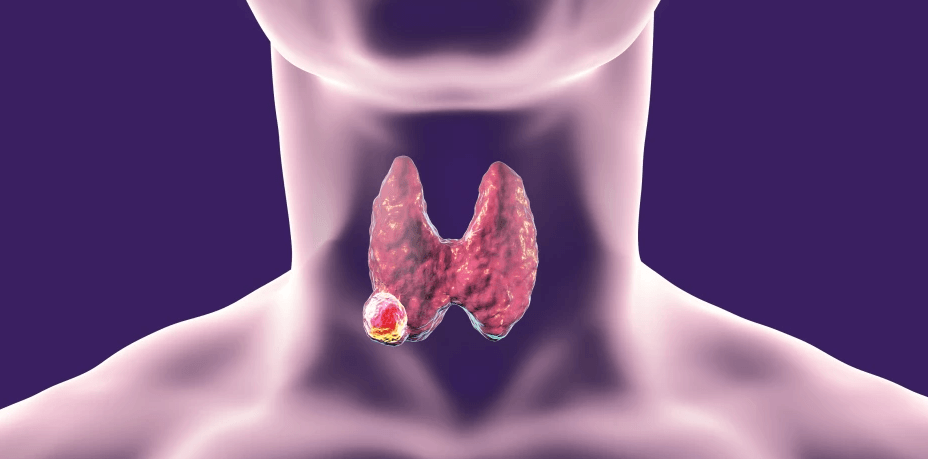
Thyroid cancer represents one of the most frequently diagnosed endocrine malignancies. It is broadly categorized into differentiated and undifferentiated forms. The differentiated category primarily comprises papillary and follicular thyroid carcinomas, whereas the undifferentiated category includes medullary and anaplastic thyroid cancers. Among these, papillary carcinoma is the most commonly encountered subtype. Follicular thyroid carcinoma is the second most prevalent, constituting approximately 10–15% of all thyroid malignancies. Undifferentiated variants occur far less frequently.
Follicular thyroid cancer is a tumor of the follicular cells of thyroid, that are cuboidal epithelial cells and have capsular and vascular invasive properties.
Follicular Carcinoma Incidence
- Most commonly affects individuals in the fifth decade of life, and is rarely seen in patients under 30 years of age.
- Accounts for 10–20% of all thyroid cancers, making it less common than papillary carcinoma.
- Shows a female predominance with a female-to-male ratio of approximately 3:1.
- Iodine deficiency is recognized as a significant risk factor.
- May develop de novo or from a preexisting follicular adenoma.
Clinical presentation
- Patients typically present with a solitary thyroid nodule, although in some cases, malignant transformation in a long-standing goiter may be observed.
- Symptoms of thyroid dysfunction (hypo- or hyperthyroidism) are uncommon, and most patients remain clinically euthyroid.
- Metastatic disease may manifest as bone pain, pathological fractures, cough, or respiratory difficulty, particularly in cases of advanced disease.
Investigations
- Ultrasound (USG) of the neck typically shows iso- to hypoechoic nodules with central vascularity, irregular margins, and sometimes a peripheral halo. Elastography and Doppler ultrasound may aid in further characterizing vascularity and stiffness, helping to stratify malignancy risk.
- On cross-sectional imaging, both CT and MRI may demonstrate well-defined, solid, contrast-enhancing lesions, sometimes with features such as cystic degeneration or calcifications. In more aggressive cases, evidence of local invasion may be observed.
- While fine-needle aspiration cytology (FNAC) is useful in identifying follicular-patterned neoplasms, it cannot reliably distinguish follicular adenoma from carcinoma due to the necessity of detecting capsular and/or vascular invasion. Therefore, definitive diagnosis requires histopathological examination of a thyroidectomy specimen, which may involve hemithyroidectomy, completion thyroidectomy, or total thyroidectomy, depending on the clinical context.
- Usually solitary “cold” nodule on radionuclide scan
Histology
- Macroscopic Features:
- Typically presents as a well-encapsulated lesion.
- Grossly, lesions are typically well-circumscribed and encapsulated, and can be categorized based on the presence or absence of capsular or vascular invasion.
- Microscopic Features:
- The nuclei are generally non-vesicular in appearance.
- Psammoma bodies are characteristically absent.
- Although follicular neoplasms can be identified via fine-needle aspiration cytology (FNAC), it is not possible to distinguish between follicular adenoma and carcinoma cytologically. Surgical excision, typically in the form of hemithyroidectomy or lobectomy, is required for definitive diagnosis. Histopathological confirmation of malignancy is based on the presence of capsular and/or vascular invasion.
- According to the WHO Classification of Tumours of Endocrine Organs (2017):
- Minimally invasive: Confined capsular invasion
- Encapsulated angioinvasive: Limited vascular invasion (<4 vessels)
- Widely invasive: Diffuse infiltration of the thyroid and surrounding tissues
Differential diagnosis
- Based on the histopathology, other diagnosis are – follicular variant of papillary thyroid carcinoma, papillary thyroid carcinoma, noninvasive follicular thyroid neoplasm with papillary-like nuclear features or NIFTP, and follicular adenoma.
Molecular studies
- NRAS and HRAS mutations are found in up to 50% of cases
- PAX8–PPARγ rearrangements are seen in approximately 36%, with around 3% showing both mutations
- Alterations in the PI3K/AKT or RAS pathways are common
- PI3CA and PTEN mutations occur in 5–10% of tumors
- Tumors with PAX8–PPARγ rearrangement tend to be more invasive
- Widely invasive carcinomas exhibit a higher frequency of allelic loss compared to minimally invasive ones
Staging of Follicular Carcinoma Thyroid
- The AJCC-TNM staging system for thyroid cancers is used to stage differentiated thyroid carcinoma (papillary and follicular carcinoma thyroid).
Follicular Carcinoma Treatment
- The primary modality of treatment for follicular thyroid carcinoma is surgical resection – hemi thyroidectomy / total thyroidectomy followed by radioiodine ablation and thyrotropin suppressing medications.
- For tumors larger than 1 cm, total thyroidectomy is recommended.
- Preoperative staging with neck ultrasound and cross-sectional imaging is recommended to assess local invasion and distant metastases.
- A repeat radioactive iodine scan is usually performed at six months post-treatment, with a second dose of RAI administered if necessary.
- For patients with metastasis to bones and soft tissues, either radiotherapy or chemotherapy, or both are indicated after the total thyroidectomy.
- In patients with progressive or metastatic disease refractory to RAI, targeted therapy with tyrosine kinase inhibitors (TKIs) such as sorafenib, lenvatinib, vandetanib, and cabozantinib has shown benefit in delaying disease progression and improving progression-free survival.
- Serial monitoring of serum thyroglobulin (Tg) levels as a tumor marker.
Prognosis
- Lymph node metastasis is uncommon, seen in ~10% of cases; fewer than 5% present with ipsilateral lymphadenopathy.
- Hematogenous spread is more frequent, especially in widely invasive carcinomas, with common sites being bone, lungs, liver, and brain (20–30%).
- Bone metastases are associated with worse prognosis compared to pulmonary metastases.
- Poor prognostic factors include:
- tumor size greater than 4 cm,
- distant metastases,
- age greater than 45 years,
- large size,
- extensive vascular invasion,
- extrathyroidal extension
- The overall 10-year survival rate for follicular thyroid carcinoma is approximately 85%.
- For minimally invasive cancers, 10-year survival is reported to be 98%,
- For invasive follicular cancer, it is 80%.
- Tumors with capsular invasion alone have a better prognosis than those with both capsular and vascular invasion.
- Approximately 50% of patients with lung metastases treated with RAI survive for 10–15 years.